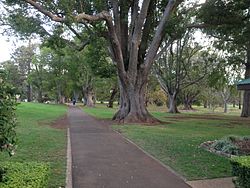Queens Park, Toowoomba
| Queens Park, Toowoomba | |
|---|---|

Park path, 2014
|
|
| Location | 43-79 Lindsay Street, East Toowoomba, Toowoomba, Toowoomba Region, Queensland, Australia |
| Coordinates | 27°33′34″S 151°57′41″E / 27.5595°S 151.9613°ECoordinates: 27°33′34″S 151°57′41″E / 27.5595°S 151.9613°E |
| Design period | 1870s - 1890s (late 19th century) |
| Built | 1875 - 1970s |
| Official name: Toowoomba Queens Park and Botanic Gardens, Toowoomba Queen's Park | |
| Type | state heritage (landscape, built) |
| Designated | 27 April 2001 |
| Reference no. | 601607 |
| Significant period | 1869, 1875 (historical) 1869- ongoing (social) |
| Significant components | cannon, garden - bed/s, pathway/walkway, wall/s, sports field/oval/playing field, tree groups - avenue of, trees/plantings, memorial/monument |
Queens Park is a heritage-listed botanic garden at 43-79 Lindsay Street, East Toowoomba, Toowoomba, Queensland, Toowoomba Region, Australia. It was built from 1875 to 1970s. It is also known as Toowomba Botanic Gardens. It was added to the Queensland Heritage Register on 27 April 2001.
The Queen's Park and Botanic Gardens, Toowoomba was gazetted as a public reserve in 1869. It was not until the mid 1870s that the Queens Park and Botanic Gardens were established as separate, but related, entities on this land. Queens Park was intended as a place of public recreation and the Botanic Gardens as a place for botanic research.
Urban public parks became a popular vehicle for 19th century movements concerned with public health - the park provided a place for the outdoor recreation of those unable to afford private gardens and improved the environment of crowded central city and town areas. Botanic Gardens were started as part of an increasing interest in scientific understanding of the natural world. A botanic gardens was established in Brisbane in 1855 in response to 19th century interest in botany which saw botanic gardens established around the world, particularly in those colonized areas of the world where little formal knowledge of the interaction between geography and botany existed. An integral part of the Brisbane Botanic Gardens was a series of branch gardens in provincial areas throughout Queensland which provided botanic data across the wide spectrum of Queensland ecosystems.
Soon after Toowoomba was proclaimed a municipality on 19 November 1860, William Henry Groom, an early Toowoomba mayor and later Member of the Queensland Legislative Assembly, lobbied the colonial government for an area of land for public recreation. A constant theme over Groom's long political career was his interest in the development of Toowoomba as a major centre and of the associated rural interests of the surrounding fertile farming area. In 1861 land was reserved for a Toowoomba recreation park but this was not the eventual site. By September 1869 the present site was surveyed and reserved for public reserve but many years were to elapse before any further progress was made of the layout or even rudimentary planting. The land chosen for the reserve was an L shaped block bounded by streets that were to become Margaret, Lindsay, Hume, Godsall and Campbell Streets very near the centre of the growing town. Until further development of the site it was variously used to graze cattle and horses, and as a source of clay for bricks for use in government buildings. These uses left the park in poor condition with holes pitted throughout and in no way like the public parks on which it was modelled. Although initially the reserve was under the control of the Colonial Queensland Government, by the end of the 1860s the Toowoomba Council was vested with the control of all parks in the municipality. However it was not until 1892 that the Council was formally vested with the title to the land, on the condition that the whole area remain a recreation ground and be used for no other purpose.
...
Wikipedia


